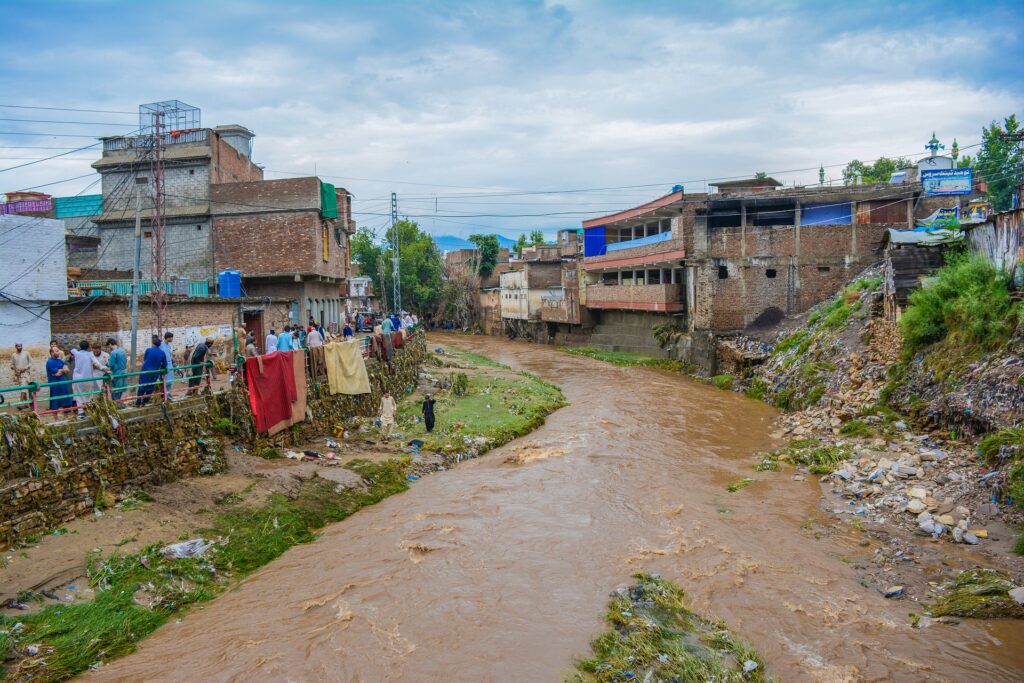Following an extreme heat wave, heavy rains and glacier melting, over a third of Pakistan is underwater. Houses and roads have been destroyed, with an estimated overall 10 billion USD worth of damages. Moreover, over 33 million civilians have been displaced and more than 1,300 people have been killed. The floods have also wreaked havoc on the country’s agriculture; crops, livestock, and food storages have been damaged, propelling the country into a looming hunger crisis. These events come on the heels of Pakistan’s existing economic issues. Now, many don’t know how they will pay their bills.
The direct cause of these floods are the aforementioned heavy rains that occurred during the summer monsoon season and the melting glaciers. These factors themselves resulted from an intense heatwave in May; warmer air can hold more moisture, and warnings were issued expecting potentially heavier rains during the summer. The rains that arrived exceeded all expectations. The extreme heat also melted the glaciers in the northern regions of Pakistan, which increased water levels in the Indus River, a river which runs the length of the country. These factors also coincided with a tropical depression in the Arabian Sea, whose winds brought heavy rains to Pakistan’s coast, and the early arrival of the monsoons, both which only exacerbated the flooding.
Indirectly, the flood’s severity can be linked to climate change and human factors. The May heatwave and following rains are likely due to climate change, as global temperatures have risen with the increase of greenhouse gasses in the atmosphere as instances of extreme temperatures continue to increase in frequency. These higher temperatures, particularly at sea, allowed clouds to travel farther over land, releasing heavy rains on areas that previously weren’t at risk for flooding.
But what about other human factors? In an interview with The Third Pole, Ali Tauqeer Sheikh, a leading climate change expert in Pakistan, breaks down the factors beyond climate change that contributed to the degree of damage that is occurring in these floods. One such component is the country’s infrastructure, which is extremely poor. As a result, 1.2 million houses, 5,000 kilometers of roads and more than 240 bridges have been destroyed. A 100-kilometer-wide body of water has even formed in the land around the Indus River, which continued to grow throughout the floods.
A city that has been particularly affected by ineffective infrastructure is Karachi. The rainfall would not have incurred much damage in a well-run city; however, Karachi, a city that uses pipes implemented by the British 75 years ago, suffered extensive damages. At least 30 people in the city died as a result of the flooding, and many more had to be rescued from inundated offices. Another human factor is the large number of people who live in flood zones. Overall in Pakistan, migration has risen by 24% in the last ten years. Migration in particular to bodies of water has risen due to climate change; increased heat has caused droughts and a subsequent loss of crops, forcing people to move to the city and near water. These people experience increased vulnerability to flooding, snow storms, and mudslides.
Many climate change experts in Pakistan believe the government must take responsibility in preventing such migration to high-risk flood areas. Pakistan’s Minister of Climate Change, Senator Sherry Rehman says there were people living near bodies of water with known tendencies to flood who absolutely should not have been permitted to settle there.
In fact, it is the government’s responsibility to prevent migration to water-rich cities, and their failure to do so means they are partially responsible for flood damages. In his interview, he states that the government should enforce laws that prohibit such settlements and give incentives to follow them, such as compensation if they live elsewhere. He gives an example of Canada, who gave cash reimbursements to people to not rebuild in flood areas.
A third factor contributing to severe damage is the lack of competent disaster management procedures. The government has not taken climate change into account in planning for the future, leaving it vulnerable, as with the example of permitting migrants to settle by bodies of water. The city of Karachi is another example, as much of Pakistan’s infrastructure is not built to withstand such copious amounts of rain; nor did it have to, in the past. But as extreme weather becomes more commonplace, the infrastructure must be updated to accommodate it. Responses to such disasters need to be region-specific, as each town’s landscape, infrastructure, and population is different, but political barriers stand in the way. Pakistan operates in a three-tier system of government, national, provincial, and local. However, the last local government dissolved in 2020, and since, administration on the smaller scale has been run by representatives sent from the provincial governments. National policymakers lack the time, knowledge and inclination to create region-specific disaster responses.
In addition to disaster preparedness, citizens have also taken issue with the country’s response to the floods, as they feel they have been left by the government to fend for themselves with no promise of evacuation aid. In a quote for The New York Times, one farmer from Sindh Province says, “There was not a single government official…in our village to help us evacuate.” One factor is the ongoing rain: evacuation helicopters were unable to be deployed because of the torrential weather. Pakistan also deployed all three arms of its military in rescue, but still didn’t have enough forces because of the sheer extent of the flooding. There are some volunteer citizens who are doing what they can to help those affected; one such example is Imran Lodhi, a university teacher who went with his students to bring food and tents to people in need. He says, “[The] government has also tried, but it’s very limited. It seems like the crisis is beyond their capacity. And now at least we have been able to mobilize people in communities who are trying to reach these areas to help these people…if some relief effort at large scale doesn’t happen, this can transform into a humanitarian crisis.”
There is a shared responsibility in these floods. On the one hand, developed countries have contributed significantly more to climate change, while Pakistan has faced the consequences, ranking eighth in countries most vulnerable to climate change-induced extreme weather. In this way, other countries have a responsibility to aid Pakistan in its recovery. On the other hand, there are improvements to be made in Pakistan in prevention and response to such disasters. Policymakers must focus on both current relief needs and instituting long-term plans to try to prevent a disaster of the same scale from occurring again.







